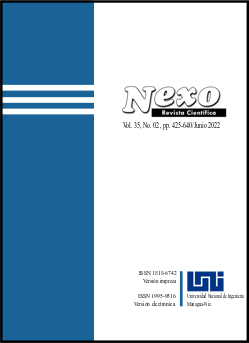Effect of APH treatment on the preservation of mango fruit (Mangifera indica) Kent variety
DOI:
https://doi.org/10.5377/nexo.v35i02.14625Keywords:
Mango (Mangifera indica var. Kent), High Hydrostatic Pressures (APH/HHP), conservation, Salmonella, E. coli, Listeria monocytogenesAbstract
The present experimental research study was carried out with the purpose of determining the growth, inhibition or destruction of pathogens on days 0 (t0), 7 (t7), 15 (t15) and 30 (t30); by treatment of HHP 400 and 500 MPa, using the method of quantification or counting of cfu colony-forming units, on three different cocktails of bacteria, such as Listeria monocytogenes, Escherichia coli and Salmonella, the microbial contained in the epicarp or peel of the mango fruit was also investigated. The results in this study show that the application of high hydrostatic pressures, with a treatment of 400 MPa of pressure 8 min of duration, managed to eliminate a load of 5.16 Log, cfu count / gr of the day t0, under conditions of 20 ºC of temperature, on sample of Mangifera indica, var. Kent, with a pH of 3.4, on L. monocytogenes under the same conditions was performed in treatment of 500 MPa of pressure with 8 min of time, having a reduction of 4.64 Log, in a t0, HHP treatments was efficient reducing 6 Log, for t7, t15 t30. Similarly, an inactivation of Salmonella was achieved in t0, for HHP 400 MPa 7.74 Log was eliminated, and in 500 MPa 6.84 Log, for a pure culture with a control load of 9.14 Log, it was observed that, in the case of treatments, they do not present bacterial growth, as several authors argue, causing death by cell damage at times t7, t15, t30. Likewise, E. coli was studied, for t0, there was a reduction in HHP treatments of 400 MPa of 5.64 Log, for HHP 500 a reduction of 5.04 Log, it was observed that in the treatments there was cell damage in t7, t15 and t30 existing a total reduction, it is concluded that in the case of E. coli according to the data obtained there was a total reduction of bacteria. The microflora of the mango skin was studied, it was established that there was a reduction of 3 Log, on average general for treatments of 400 and 500 MPa for times t0, t7, t15 and t30, observing a resistance for both treatments, due to the presence of yeasts.
Downloads
1792
Downloads
Published
How to Cite
Issue
Section
License
Copyright (c) 2022 Universidad Nacional de Ingeniería

This work is licensed under a Creative Commons Attribution 4.0 International License.
The authors who publish in Nexo Scientific Journal agree to the following terms:
- Authors retain the copyright and grant the journal the right of the first publication under the license Creative Commons Attribution License, which allows others to share the work with a recognition of the authorship of the work and the initial publication in Nexo Scientific Journal.
- Authors may separately establish additional agreements for the non-exclusive distribution of the version of the work published in the journal (for example, in an institutional repository or a book), with the recognition of the initial publication in Nexo Scientific Journal.
- Authors are allowed and encouraged to disseminate their works electronically (for example, in institutional repositories or in their own website) before and during the submission process, as it can lead to productive exchanges, as well as earlier and greater citation of published works.










